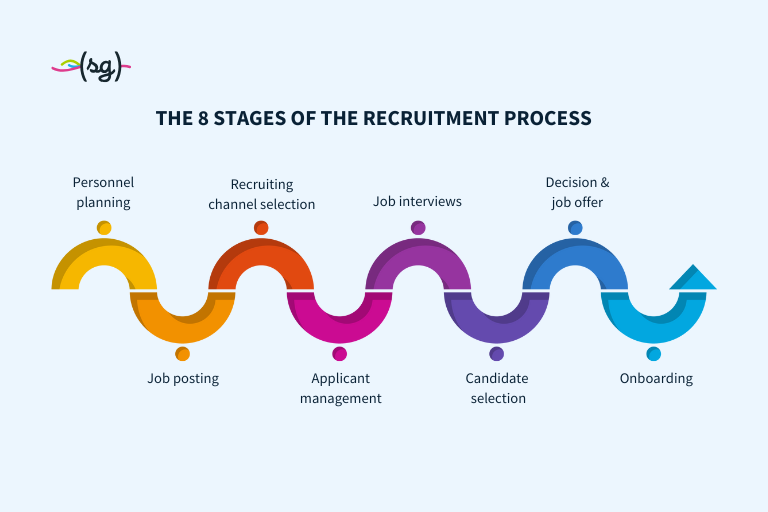Henry Ford once said: “Half the money I spend on advertising is wasted; the trouble is I don’t know which half.” Do you know how your personnel marketing is doing here?
In this article, you will learn which indicators are important in recruiting and how to collect them. That way you can optimize your recruiting processes.
Content
The best recruiting strategy is useless without good success control.
This is where recruiting KPIs come into play: if used correctly, these key performance indicators or recruiting indicators are an effective tool to first measure and then evaluate the processes involved in personnel recruitment.
In many cases, it takes just a few clicks to identify where there is room for improvement in recruiting.
How widespread is the use of recruiting analytics?
Although almost all companies know how important effective benchmarking in recruiting is, in practice only a few employers make use of sophisticated recruiting analytics.
According to a VONQ study, 61 % of the interviewed recruiters have difficulty finding suitable candidates for open positions.
For this reason, 47% of the respondents consider recruiting analytics, i.e. data-based insights into the application process, to be increasingly important.
However, only 7% of all recruiters would describe their company as well positioned in this context.
Why should you collect recruiting KPIs?
But what can be specifically evaluated by collecting the right indicators in recruiting?A practical example: social media, your own career site, and job exchanges – in personnel marketing, many different channels are used to reach potential candidates.But how do the individual channels perform?Recruiters are often in the dark when it comes to this question.
Best practice: determining the best recruiting channel
So they cannot judge exactly which channel is necessary or which channel could be switched off.
This might cost unnecessary money, which would be better invested elsewhere.
Modern online tracking technologies shed light on the problems at hand:
- They identify the channels in which your company made initial contact with the applicant.
- They evaluate the most popular channels and those that are rarely used.
- You find the channels that brought many applicants but no hires.
- You identify the channels that have brought new team members to your company.
Save time and money in the application process
Depending on what you want to find out, you can set different priorities when measuring recruiting KPIs.
For example, if the focus is on the application process its self, classic recruiting KPIs such as time-to-hire, time-to-fill, or cost-per-hire are recommended.
These KPIs answer the question of how much time elapses between the notification of staffing requirements and the filling of a position and what costs the company incurs per position on average.
In addition, suitable KPIs can be used to establish processes to get to know the target group better:
- How many male and female candidates have applied?
- How satisfied are the applicants with the recruiting process?
- How well does the application process reflect the future job?
All these facts, figures, and data can be combined in various ways to create a multi-faceted overall impression.
What are the key recruiting indicators?
We have listed some of the most common KPIs below as well as a detailed explanation of their meaning. We also explain what conclusions you can draw from the KPIs.
| Recruiting KPI | Definition of the recruiting key performance indicator |
| Time-to-Interview | The time span from the announcement of an open position to the first |
| Time-to-Hire / Time-to-Fill | The time that elapses from the job advertisement to the final filling of the position |
| Cost-per-Hire | The costs incurred for filling a position |
| Rejection rate | The percentage of applications that are rejected immediately (e.g. due to not meeting minimum requirements) |
| Channel-Effectiveness | Which recruiting channel works best? |
| Quality-of-Hire | How well do new talents fit the job? |
| Candidate-Satisfaction | Candidate satisfaction with the application process |
| Early fluctuation | How many talents leave the company already during the onboarding phase? |
| Cost-of-Vacancy | What does an unfilled position cost? |
| Offer-Rate | Ratio of published job offers in relation to the number of candidates |
| Offer-Acceptance-Rate | What is the percentage of candidates who accept a position? |
| Hiring-Manager-Satisfaction | How satisfied are recruiters with the recruiting process? |
What does which recruiting KPI mean?
Time-to-Interview
Time-to-interview refers to the time span from the announcement of an open position to the first meeting.
This key figure is directly related to the speed of your application process. It can therefore also be used as an indicator for your candidate experience.
A quick invitation to the interview not only creates a positive impression, but also accelerates the further application process and ultimately gives you faster access to the best candidates.
According to the softgarden Application Report, 56.7% of applicants expect concrete feedback, i.e. an invitation or rejection, within no more than two weeks. Only a quarter of the interviewed companies met this requirement.
By the way: A sticking point when setting up job interviews is the pre-selection of candidates. Here, the personnel department and the specialist departments often have to coordinate with each other. Modern applicant tracking software can help here by accelerating this process through automation.
Users of softgarden’s applicant tracking software accelerate their time-to-interview by up to 60%.
Time-to-Hire / Time-to-Fill
Time-to-hire and time-to-fill are often used synonymously. This means the time that passes from the job advertisement until the position is finally filled. A long time-to-hire indicates a long application process. This can have many reasons.
Take a look at your application process through the candidate’s eyes.
- Are your job ads meaningful and attractive
- Have the job ads been placed on the right channels?
- How easy is it to apply to you (starting with the form)?
- How many candidates make it onto the shortlist?
- Are you receiving enough applications in total?
You can find answers to these questions by relating time-to-hire with recruiting metrics such as channel effectiveness, quality of hire, and candidate satisfaction.
A look at the number of hits on your job ads is also helpful here.
Rejection rate
The rejection rate refers to the percentage of applications that you sort out immediately after receipt.
This makes sense if the respective applicants do not meet certain minimum requirements that you have specified. The rejection rate is interesting in that it tells you whether you are actually reaching the right people with your advertisement. It is a key indicator for the correct evaluation of the effectiveness of a job advertisement.
Imagine you receive 100 applications for your ad, but you have to directly reject 90% of them, i.e. 90 applications, because one or the other exclusion criterion was not met.
Of course, this also reduces the chances of finding the right person for your position – even if 100 applications received look promising at first.
Now you can start troubleshooting: Are you using the right channel? Does your job advertisement contain all important information? Do the job requirements fit?
A good e-recruiting system allows you to evaluate the rejection rate and reasons for rejection in one go.
Channel Effectiveness
With the channel effectiveness indicator, it is possible to assess which recruiting channel will bring the hoped-for success and which will not.
This can be found out very easily with the online tracking of the individual campaigns. Here you can get an exact overview of how often an ad was viewed on specific channels.
You can also find out whether the candidates only viewed the ad or whether they also clicked on the apply button.
If the discrepancy between these values is very high, it could be because the wrong target group was reached. This allows you to determine very precisely which channel mix works best for certain locations.
Quality-of-Hire
The quality-of-hire measures the quality of new hires.
In other words, this recruiting KPI provides information on whether a newly hired employee has contributed to the success of the company within a certain period of time.
The basis for calculating the quality-of-hire is the measured performance.
The quality-of-hire allows to draw conclusions about the quality of the recruiting. Clearly, the higher the quality-of-hire, the more precisely the recruiting is tailored to the company’s needs.
Obviously, exactly the talents that needed to be addressed were reached.
In comparison with other recruiting KPIs such as channel effectiveness, recruiters can determine which applicant came to the company via which recruiting channel. This allows them to identify channels that deliver the highest quality-of-hire.
Candidate Satisfaction
Candidate satisfaction is a measure of how a candidate perceives the hiring process, the candidate experience, of your company.
The better the candidate satisfaction, the greater the likelihood that candidates will stay on the ball during the application process and not drop out of frustration.
In addition, satisfied candidates are more likely to promote a company than dissatisfied ones.
For instance, they share their experiences on social media or employer evaluation platforms.
But how do you determine candidate satisfaction?
By asking directly!
You can ask for feedback after a job interview or you can do an electronic survey among candidates and find out easily where things are going well in the recruiting process and where there are problems.
Also take a look at the satisfaction scores on employer evaluation platforms like kununu – these often provide insightful information.
Early fluctuation
The early fluctuation indicator shows how many employees leave the company shortly after being hired.
This is before they have been fully trained and integrated into their team.
A high early fluctuation rate costs companies a lot of money.
If employees leave, the recruiting process starts all over again – with all the associated costs.
Well-structured onboarding processes help to reduce early turnover, motivate employees, retain employees, and save a lot of effort.
Cost-per-Hire
This recruiting KPI is the average cost of filling a job.
It also shows how well the in-house recruiting department performs.
The lower the costs, the more efficient the recruitment process.
The cost-per-hire is calculated as the sum of internal and external recruiting costs divided by the number of new hires. An overview of the recruiting costs is also important to estimate and negotiate the required recruiting budget.
If you keep exact accounts, you have a good basis for argumentation to get that last small change you need approved.
Cost-of-Vacancy
The cost of an unfilled vacancy can be calculated with the cost-of-vacancy.
The calculation is based on the assumption that an employee generates a measurable share of the company’s turnover.
The company would not have this share if the corresponding position remained unfilled.
The cost of vacancy can be calculated by dividing the annual salary of the employee in question by the number of working days in a year.
The salary per working day is then multiplied by a factor of 1, 2 or 3, depending on the economic importance of the position, and then by the number of days it takes to fill the position.
Let’s assume that the position for a marketing manager, who receives an annual salary of around 120,000 Euros, needs to be filled.
This strategic position has a very high impact on the company’s revenues.
Therefore, a factor of 3 is used in the calculation.
This results in the following:
120,000 Euros : 251 WD = 478 Euro/day x 3 = 1,434 Euros/day
Meaning: The missing employee equals a loss of sales of 1,434 Euros per day.
The cost of vacancy shows how essential it is for a company to fill a specific position.
Offer-Rate
The offer rate puts the candidates for a specific position in relation to the number of published job offers.
Offer-Acceptance-Rate
The offer acceptance rate is used to determine the percentage of applicants who have actually accepted a job during the application process or who have left after the job was accepted.
This recruiting KPI thus shows how successfully a company fills its vacancies.
If the offer acceptance rate is low, this may be due to the lack of attractiveness of the recruiting process. Or the position itself may not appear attractive enough to applicants.
In this case, a subsequent satisfaction survey is recommended, for example, to find out what the problem was and to solve the existing problems.
Hiring-Manager-Satisfaction
Hiring manager satisfaction indicates the satisfaction rate of recruiters with the existing recruiting process – a figure that is quite important.
After all, an efficient recruiting process ultimately determines the success of quick and suitable filling of vacancies.
This makes it all the more important that all work flows fit and everything goes hand in hand.
And who better than the recruiter himself to provide information about this?
They can say very specifically where there is room for improvement.
So it’s worthwhile to look into this.
Ultimately, every company has to find out for itself what a good, meaningful mix of recruiting KPIs looks like. You can collect all the data you want and still may be unable to make a real statement on the core issues. The decisive factor is a balanced KPI system that is not one-sidedly geared towards high speed or cost minimisation, but rather combines several aspects and is ideally also linked to the strategic corporate goals.
Did you know that an applicant tracking software actively assists you in recording recruiting KPIs? Let our experts explain to you how softgarden applicant tracking supports you in building a reliable database for your recruiting.





